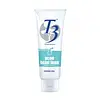What's inside
What's inside
 Key Ingredients
Key Ingredients

 Benefits
Benefits

 Concerns
Concerns

No concerns
 Ingredients Side-by-side
Ingredients Side-by-side

Water
Skin ConditioningSodium Cocoyl Glycinate
CleansingSodium Taurine Cocoyl Methyltaurate
CleansingPotassium Olivate
EmulsifyingSorbitol
HumectantCeramide NP
Skin ConditioningCeramide EOP
Skin ConditioningCeramide AP
Skin ConditioningCeramide As
Skin ConditioningCeramide Ns
Skin ConditioningCentella Asiatica Extract
CleansingSodium Hyaluronate
HumectantTuber Magnatum Extract
Skin ConditioningPhosphatidylcholine
EmulsifyingHydrogenated Lecithin
EmulsifyingAscorbyl Palmitate
AntioxidantTocopherol
AntioxidantLactobacillus/Soymilk Ferment Filtrate
Skin ConditioningSaccharomyces Ferment Lysate Filtrate
Skin ConditioningBifida Ferment Filtrate
Skin ConditioningBifida Ferment Lysate
Skin ConditioningLysine
Skin ConditioningHistidine
HumectantArginine
MaskingAspartic Acid
MaskingThreonine
Serine
MaskingGlutamic Acid
HumectantProline
Skin ConditioningGlycine
BufferingAlanine
MaskingValine
MaskingIsoleucine
Skin ConditioningLeucine
Skin ConditioningTyrosine
MaskingPhenylalanine
MaskingC12-13 Alkyl Lactate
EmollientCitric Acid
BufferingDisodium EDTA
Maltooligosyl Glucoside
Skin ConditioningHydrogenated Starch Hydrolysate
HumectantSodium PCA
HumectantGlycerin
HumectantButylene Glycol
HumectantWater, Sodium Cocoyl Glycinate, Sodium Taurine Cocoyl Methyltaurate, Potassium Olivate, Sorbitol, Ceramide NP, Ceramide EOP, Ceramide AP, Ceramide As, Ceramide Ns, Centella Asiatica Extract, Sodium Hyaluronate, Tuber Magnatum Extract, Phosphatidylcholine, Hydrogenated Lecithin, Ascorbyl Palmitate, Tocopherol, Lactobacillus/Soymilk Ferment Filtrate, Saccharomyces Ferment Lysate Filtrate, Bifida Ferment Filtrate, Bifida Ferment Lysate, Lysine, Histidine, Arginine, Aspartic Acid, Threonine, Serine, Glutamic Acid, Proline, Glycine, Alanine, Valine, Isoleucine, Leucine, Tyrosine, Phenylalanine, C12-13 Alkyl Lactate, Citric Acid, Disodium EDTA, Maltooligosyl Glucoside, Hydrogenated Starch Hydrolysate, Sodium PCA, Glycerin, Butylene Glycol
Water
Skin ConditioningCocamidopropyl Hydroxysultaine
CleansingDisodium Cocoyl Glutamate
CleansingSodium Lauroamphoacetate
CleansingPEG-120 Methyl Glucose Dioleate
EmulsifyingCitric Acid
BufferingStyrene/Acrylates Copolymer
Phenoxyethanol
PreservativeOlive Oil PEG-7 Esters
EmollientMethylpropanediol
SolventAllantoin
Skin ConditioningMelaleuca Alternifolia Leaf Oil
AntioxidantSodium Chloride
MaskingDisodium EDTA
Ethylhexylglycerin
Skin ConditioningO-Cymen-5-Ol
Antimicrobial4-Terpineol
MaskingEpilobium Angustifolium Flower/Leaf/Stem Extract
Skin ConditioningSalicylic Acid
MaskingSalix Alba Bark Extract
AstringentSodium Metabisulfite
AntioxidantWater, Cocamidopropyl Hydroxysultaine, Disodium Cocoyl Glutamate, Sodium Lauroamphoacetate, PEG-120 Methyl Glucose Dioleate, Citric Acid, Styrene/Acrylates Copolymer, Phenoxyethanol, Olive Oil PEG-7 Esters, Methylpropanediol, Allantoin, Melaleuca Alternifolia Leaf Oil, Sodium Chloride, Disodium EDTA, Ethylhexylglycerin, O-Cymen-5-Ol, 4-Terpineol, Epilobium Angustifolium Flower/Leaf/Stem Extract, Salicylic Acid, Salix Alba Bark Extract, Sodium Metabisulfite
 Reviews
Reviews

Ingredients Explained
These ingredients are found in both products.
Ingredients higher up in an ingredient list are typically present in a larger amount.
Citric Acid is an alpha hydroxy acid (AHA) naturally found in citrus fruits like oranges, lemons, and limes.
Like other AHAs, citric acid can exfoliate skin by breaking down the bonds that hold dead skin cells together. This helps reveal smoother and brighter skin underneath.
However, this exfoliating effect only happens at high concentrations (20%) which can be hard to find in cosmetic products.
Due to this, citric acid is usually included in small amounts as a pH adjuster. This helps keep products slightly more acidic and compatible with skin's natural pH.
In skincare formulas, citric acid can:
While it can provide some skin benefits, research shows lactic acid and glycolic acid are generally more effective and less irritating exfoliants.
Most citric acid used in skincare today is made by fermenting sugars (usually from molasses). This synthetic version is identical to the natural citrus form but easier to stabilize and use in formulations.
Read more about some other popular AHA's here:
Learn more about Citric AcidDisodium EDTA plays a role in making products more stable by aiding other preservatives.
It is a chelating agent, meaning it neutralizes metal ions that may be found in a product.
Disodium EDTA is a salt of edetic acid and is found to be safe in cosmetic ingredients.
Learn more about Disodium EDTAWater. It's the most common cosmetic ingredient of all. You'll usually see it at the top of ingredient lists, meaning that it makes up the largest part of the product.
So why is it so popular? Water most often acts as a solvent - this means that it helps dissolve other ingredients into the formulation.
You'll also recognize water as that liquid we all need to stay alive. If you see this, drink a glass of water. Stay hydrated!
Learn more about Water